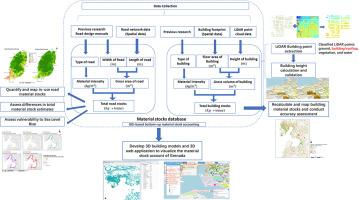3D GIS modelling of road and building material stocks: A case study of Grenada
IF 10.9
1区 环境科学与生态学
Q1 ENGINEERING, ENVIRONMENTAL
引用次数: 0
Abstract
Quantifying and mapping material stocks is crucial for built environment stock management and sustainable planning. This study presents a Geographic Information System (GIS)-based bottom-up approach for modelling road and building material stocks in Grenada, a small island state. Light Detection and Ranging (LiDAR) data were utilized to estimate building heights and building stocks. The first 3D WebGIS application was developed for Grenada to visualize material stocks in 3D city models. The road stocks in Grenada were estimated to be 4375 kilo tonnes (40.96 t/capita) in 2015, about one-third of building stocks, highlighting the importance of infrastructure stocks in small island states. LiDAR-derived building heights were more accurate, estimating building stocks 4.8 % lower than occupancy class-based height assumptions in the sample site. This study develops Grenada’s first road stock account and assesses a novel methodology for estimating building stocks in small island states, offering insights for enhancing resource assessment and management.

道路和建筑材料库存的三维GIS建模:格林纳达的案例研究
量化和绘制材料库存对建筑环境库存管理和可持续规划至关重要。本研究提出了一种基于地理信息系统(GIS)的自下而上的方法,用于模拟小岛屿国家格林纳达的道路和建筑材料库存。利用光探测和测距(LiDAR)数据来估计建筑物高度和建筑物存量。第一个3D WebGIS应用程序是为格林纳达开发的,用于在3D城市模型中可视化材料库存。2015年,格林纳达的道路库存估计为4375千吨(40.96吨/人均),约为建筑库存的三分之一,凸显了小岛屿国家基础设施库存的重要性。激光雷达得出的建筑高度更准确,估计的建筑存量比样本地点基于占用等级的高度假设低4.8%。本研究开发了格林纳达的第一个道路存量账户,并评估了估算小岛屿国家建筑存量的新方法,为加强资源评估和管理提供了见解。
本文章由计算机程序翻译,如有差异,请以英文原文为准。
求助全文
约1分钟内获得全文
求助全文
来源期刊

Resources Conservation and Recycling
环境科学-工程:环境
CiteScore
22.90
自引率
6.10%
发文量
625
审稿时长
23 days
期刊介绍:
The journal Resources, Conservation & Recycling welcomes contributions from research, which consider sustainable management and conservation of resources. The journal prioritizes understanding the transformation processes crucial for transitioning toward more sustainable production and consumption systems. It highlights technological, economic, institutional, and policy aspects related to specific resource management practices such as conservation, recycling, and resource substitution, as well as broader strategies like improving resource productivity and restructuring production and consumption patterns.
Contributions may address regional, national, or international scales and can range from individual resources or technologies to entire sectors or systems. Authors are encouraged to explore scientific and methodological issues alongside practical, environmental, and economic implications. However, manuscripts focusing solely on laboratory experiments without discussing their broader implications will not be considered for publication in the journal.
 求助内容:
求助内容: 应助结果提醒方式:
应助结果提醒方式:


